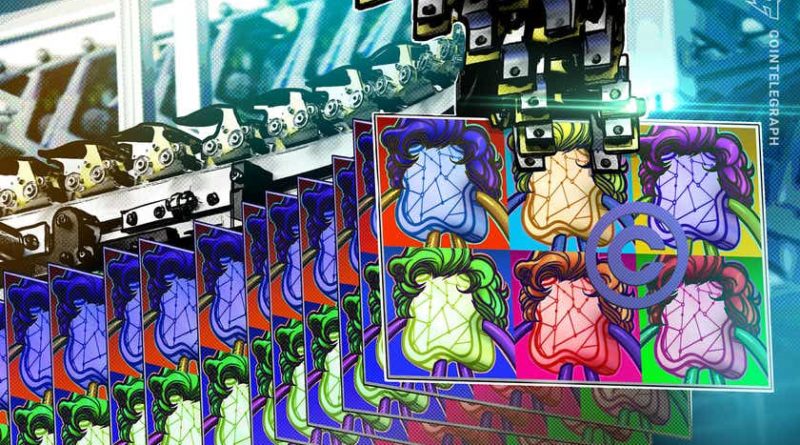NFT art will never be mass-market — NFT licenses may be
NFT digital art sales generate headline after headline, though this is not the real mass-market use of this novel technology.
Visa got itself a fancy new Twitter avatar this August, and even though it didn’t stay up for long, the 8-bit-styled picture of a visibly unamused woman with a stylish mohawk still made dozens of headlines. It was not just about the relatively hefty price tag of $150,000. The mere fact that the financial giant bought a nonfungible token (NFT) representing the image from the CryptoPunks collection set off fireworks in the media. It was the best marketing spend Visa’s done all year — the ROI on news articles alone must have paid for the purchase tenfold.
Yes, even Visa “apes in” on NFTs these days, to use an expression NFT collectors drop a lot in the era of the wealthy pouring millions into JPEGs of apes. But even though the technology’s journey from memes to riches has taken it into the digital art world, I don’t think that this will be its mass-market use case.
Name my ape! Drop your suggestions below @BoredApeYC #BAYC #BoredApeYachtClub #NFTs pic.twitter.com/pwFynGy9QJ
— jimmy fallon (@jimmyfallon) November 17, 2021
By now, everyone knows that NFTs essentially bring uniqueness and scarcity, a feature associated with traditional high art, into all shapes and forms of digital art, which is otherwise infinitely reproducible with the good old copy-paste. A link to a specific picture, audio clip or video is sent to the blockchain as part of a transaction, and there we are — even though the file can still be copy-pasted, only one wallet owns its token. That’s where it becomes a posh thing: Donning an NFT image as a Twitter avatar is like wearing a Rolex watch with your name engraved on it. It’s a status symbol to be appreciated by those in the know.
That said, high art and luxury are by definition antonymous to the mass market, as high price and uniqueness are their key selling points. Someone who’s bleeding money can buy a link for millions, but that’s because they might as well burn their money for fun, and they want to show off their wealth to the world. Good luck charging a Regular Joe $150,000 for a link to a picture, though. The focus on NFTs as art by definition limits a promising technology to a relatively small, albeit inarguably posh and eccentric, niche.
The good thing here is that the big NFT digital art sales are making headlines, which is helping to bring NFTs into the mainstream. However, this will not be the main use of NFTs further down the road, but rather a new and expensive plaything for the wealthy and some especially fervent crypto-personalities and communities.
The real deal
First of all, NFTs already have a mass-market use case — they are very much at home in gaming, with CryptoKitties gathering a ton of headlines back in the day. From Axie Infinity to all the newer titles, NFTs are powering a plethora of digital economies, and there, they bring more than sheer uniqueness to the table.
Yes, it’s nice that your NFT sword is unique and has your name on its token, but what’s nicer is that it can decapitate a dragon in one swing, unlike any other, non-unique weapon. And decapitated reptiles are what people are ready to pay for. Fortnite, a free game, brought its publisher $5.1 billion in 2020 on sales of in-game cosmetics, and gamers are already paying for non-unique weapons, mounts, castles and spaceships in dozens of other games. NFTs are just the next step in this direction. And believe it or not, in some developing countries, NFT games have already become a valid source of income.

What looks just as promising is the idea of using NFTs in the corporate world, as part of traditional business processes. The fields where NFTs will likely take off in a big way, if not become the new default way of doing things, aren’t as sexy as high-end luxury. They will, however, greatly benefit from the key feature that NFTs bring to the table: The ability to confirm the authenticity of the associated digital asset. This could be, for example, as simple as the hash of a financial document saved as an NFT on a private or a public blockchain to check whether it’s been tampered with later on.
Software licensing and authentication seems like one of the areas where NFTs will shine, given enough time, with the bonus of possible interoperability. Corporations and individuals alike could shop for licensed software pieces on a single platform, leasing it for as long as needed. This would cut the costs, while also keeping chief information officers’ peace of mind as they have an extra layer of security knowing that any digital asset can be safely and quickly authenticated.
Related: Nonfungible tokens: A new paradigm for intellectual property assets?
Those of you as old as I am remember buying copies of Windows or Adobe CS3 and having a sticker on the back of the box with your serial number. Lose the box, and that was it. This was replaced by SaaS log-ins that stored your serial number, or platforms like Steam and Apple’s App Store, which held your digital asset — except, of course, unless Apple decides it doesn’t have the rights to “Goonies HD” in the store and simply removes your purchase. You bought it? Too bad. Same if the platform was shut down, or if the company decides you somehow violated their 2,000-page terms of service that you agreed with without reading through. The point is, with subscription-based SaaS, you own nothing, even if the solution is deployed on-premise.
NFTs might fix this
Let’s say you’re buying an asset, any digital asset — music, a movie, a license for the software, limited use rights to a photo, whatever. At the moment of purchase, the platform mints a non-fungible token pointing to the original file or download location. The token acts as your proof of purchase. You store the asset locally, most likely accessing it through an app that would use your token to verify ownership (or, for example, if the license period hasn’t ended) whenever you try to interact with it, which would prevent copy-paste distribution and other IP infringements.
With the right design, such a system would even allow the transfer of ownership rights, as long as they are legally baked into the NFT. This way, after enjoying your copy of the “Goonies,” you can gift it to a friend or re-sell it, potentially with a small royalty to be paid either to whoever owns the rights for the movie or to the original seller. The latter, by the way, partially addresses the issue that fueled the shift to SaaS in the first place. Companies don’t want a secondary market because it competes with their sales, but with royalties built into NFTs, they would have a stake in every subsequent re-sale. In other words, each copy of a movie sold becomes a gift that keeps on giving.
Related: We haven’t even begun to tap into the potential of NFTs
Granted, though, the ownership part is what needs more work, especially on the legal front. None of these concepts have been tested, but they need to be, whether by an artist or a collector, just to set the precedent and start charting out a playbook for this terra incognita. Technical expertise and business or legal expertise are not the same thing. Some of us remember the EOS token sale, and how much of the funds raised had to be held until the SEC finished their investigation. Projects talking about their legality and proving their legality in court are two different things.
While the NFTs are not without their flaws, dismissing them as an inherently toxic and fraudulent technology this early into their development is, at best, rushed. Instead, what the field needs are more regulation on the one hand and more entrepreneurship on the other. Art and business walk hand-in-hand these days, and as NFTs mature, their journey from memes to riches will most likely similarly lead them into the corporate world.
This article does not contain investment advice or recommendations. Every investment and trading move involves risk, and readers should conduct their own research when making a decision.
The views, thoughts and opinions expressed here are the author’s alone and do not necessarily reflect or represent the views and opinions of Cointelegraph.




